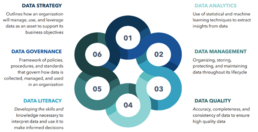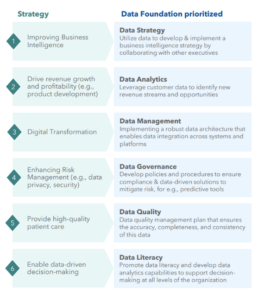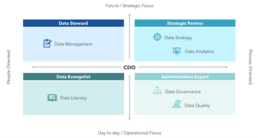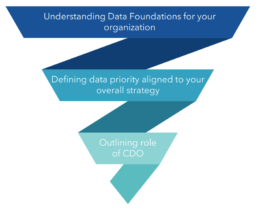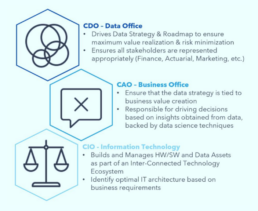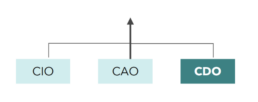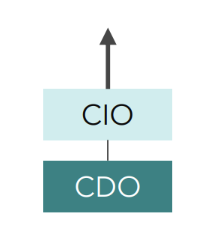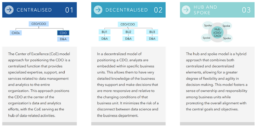The Rise of the Chief Data Officer
There are generally three main organization models for a CDO — centralized, decentralized and hub-and-spoke. Organizations should carefully consider
their specific needs and goals before deciding on which model to adopt.
INTRODUCTION
“Data is the new oil. It's valuable, but if unrefined it cannot be used.” – Clive Humby, Data Scientist.
Data has become the lifeblood of modern businesses. Its efficient
management and analysis are essential to the success of any
organization. Merely possessing large amounts of data is not enough; businesses must have the right tools, technology, and strategies in place to extract meaningful and dependable insights.
Unfortunately, businesses often under-estimate of the value that data management and governance can create. Data is often treated as an IT function and is not fully utilized, leading to compromised data quality and availability. This is where the role of a Chief Data Officer (CDO) is critical. A CDO is responsible for creating a data-driven culture across the organization, ensuring that the right data is collected, stored, managed, and analyzed efficiently.
This paper seeks to guide businesses in evaluating the need for a Chief Data Officer (CDO), outlines the CDO’s responsibilities, and suggests the optimal organization structure for this role to be effective.
THE ROLE OF A CDO
'While each sub-function is well-defined and documented, a sound Data Strategy is paramount in order to achieve success at scale.'
Data has become an indispensable asset in today’s digital age. However, many organizations lack the understanding of the basic data foundations required for effective data utilization and application. (see Exhibit 1 below).
Exhibit 1. Emerging Data Foundations
Building a Strong Foundation
Effective data management is crucial for leveraging data assets for a competitive advantage. However, before an organization can define the role of a CDO, it is crucial to establish a clear understanding of the data foundations and priorities. This can be achieved by defining key data quality, governance, security, and integration practices. By doing so, organizations can identify gaps and prioritize areas for improvement, ultimately enabling more effective data utilization and application.
To understand the responsibilities of a CDO, it is important to first understand the foundational elements of data:
1. Data Strategy
Involves the development of a strategic plan for how data will be managed and used to support business objectives. This includes establishing ground rules and a roadmap for Data Governance and Enablement, defining organizational roles and responsibilities, considering requirements from multiple stakeholders, defining business architecture, and working with IT partners to identify and implement technology solutions.
2. Data Analytics
By leveraging data analytics effectively, organizations can gain insights that support decision-making, drive business growth, and improve operations. Organizations also need to have the technical expertise and tools necessary to analyze and interpret data.
3. Data Governance
Involves ensuring data security and setting policies, procedures, and standards that govern how data is collected, managed, and used. In addition, it also includes creating a central data repository that is used across multiple systems and applications.
4. Data Literacy
Involves promoting the business value of data and educating stakeholders on its importance as well as working closely with corporate functions to enact practical changes that reflect the organization’s commitment to data quality and management. Few ways to do this is by adding data-related key performance indicators (KPIs) to the organization’s risk profile or adding data quality and data management goals to standardized HR scorecards where appropriate.
5. Data Management
Enact policies and procedures that govern the entire data lifecycle, from data ingestion to data archival to create high-quality, high-value, strategic data assets. Also, identify and manage the optimal data architecture and enable data traceability, availability, usability, and efficiency. Finally, identifying and sourcing new data to supplement existing data assets.
6. Data Quality
Establishing and managing data standards, as well as monitoring and tracking data quality using data quality dashboards. Additionally, developing processes to remedy any data quality issues that arise and setting up the appropriate organization design to ensure ongoing management of data quality. In summary, an organization must understand its data foundations and priorities before defining the role of a CDO. This ensures that the CDO can establish an effective data strategy to maximize value, drive better business outcomes, and align data priorities with the overall strategic goals.
Defining the CDOs primary business goal
Once the data foundations have been established, the organization’s data priorities and aspirations needs to be laid out. It is critical to build an understanding of the overall strategic goals of an organization, taking into consideration key factors such as it’s industry, size, customer base, competitive landscape, etc. This helps set the primary business goal of a CDO.
Exhibit 2 presents a few examples of how an organization’s overall strategy can be used to prioritize the data foundation and align with the role of a CDO.
Exhibit 2. Mapping Strategy to Data Foundation
Once an organization has prioritized its data foundation, it needs to decide on the primary role of the CDO to ensure successful execution (Exhibit 3)
Exhibit 3. Mapping data foundations to the CDO’s role
To align the CDO’s role with the organization’s objectives and data priorities, the following roles can be considered:
1. Strategic Partner
The CDO should work closely with the executive team to provide insights and guidance on how data can be used to achieve the organization’s overall goals and objectives. This includes identifying new opportunities to leverage data, developing data-driven products, and making data-based decisions.
2. Data Steward
The CDO should be responsible for working with other leaders and BUs and identify their data management needs to recommend new tools and technologies. Also, develop its data architecture as well as ensure that the organization’s data assets are properly managed, protected, and governed.
3. Data Evangelist
The CDO should be able to lead change initiatives within the organization to promote a data-driven culture among employees and empower them to make data-based decisions. This includes promoting data literacy, educating employees on the benefits of data, and working with other departments to integrate data into their workflows.
4. Administrative Expert
The CDO should manage the organization’s data assets and ensure that data is stored, processed and used in conformity with relevant regulations and policies. This includes establishing data quality standards, data security protocols, and ensuring compliance with data privacy regulations.
Exhibit 4. Defining the primary goal of a CDO
STRATEGIC PLACEMENT OF A CDO
A CDO is a senior level executive in an organization and their specific placement within an organization is critical to ensure sufficient authority, resources, and visibility
Differences between CDO, CAO, and CIO
While data analytics falls under the purview of a CDO (as defined in previous section), some organizations may have separate positions for CDO and Chief Analytics Officer (CAO) as well. Additionally, there can be some overlap with the role of Chief Information Officer (CIO), who is responsible for managing an organization’s technology infrastructure, systems, and applications. The CIO may also be involved in data management and analytics initiatives, especially those related to technology infrastructure. However, to ensure that data and analytics initiatives are successful, it’s important for organizations to clearly define these responsibilities.
While the responsibilities of the CDO, CAO, and CIO may overlap, each role has a distinct area of focus and expertise. Clearly delineating these roles and promoting collaboration between them is essential. Exhibit 5 lays down these three roles and their primary responsibilities. The next section defines the various possible hierarchical structures
Exhibit 5. CDO vs CAO vs CIO
Hierarchy for a CDO
The hierarchy for CDO can vary depending on the organization’s size, industry, and specific needs. Here are some possible org structures:
1. Reporting to a top executive, i.e., CEO
1.1. CDO, CAO, CIO at the same level
In some organizations, the role of CDO and CAO may be split in order to maintain a clear focus and ensure that each area receives sufficient attention and resources.
This split may occur when the volume of data and the depth of analytics required are vast and complex, and two separate focused executives are needed to manage each function effectively. Additionally, if several independent functions, such as Actuarial, Marketing, Finance, and others require heavy support and coordination from the CDO, having separate roles might make sense.
In this scenario, the CDO is expected to serve as a neutral conduit between the business and IT teams to optimize the organization’s management of information and related knowledge assets.
Here, all report directly to a common executive, such as the CEO. This structure highlights the importance of data to the organization’s overall strategy and ensures that data management, analytics, and technology infrastructure are all given equal weight in decision-making.
1.2. CDO combined with CAO
Consolidating the roles of the CAO and CDO to create a combined role can be a powerful strategy to prioritize data-driven decision making, innovation, and monetization. The combined role serves as the principal advocate for data within the enterprise, allowing for a deeper understanding of business performance, customer behavior, and market trends and ensuring that data is used to drive value and competitive advantage. By breaking down silos between data management and analytics, organizations can leverage their data assets fully. It can also help maximize resources and minimize duplication of effort.
Combining the roles of CDO and CAO can make sense for
organizations that have a strong focus on data and analytics, and aggressively seek to leverage data science and advanced analytical modeling to generate new insights. This approach is particularly beneficial if the analytics team has a unique, broad knowledge of enterprise data, allowing the organization to create a more comprehensive view of data and to drive new insights and innovation.
The CDO and CIO must work closely together to ensure that the data strategy is successfully implemented and operationalized. The CDO leads the strategy and governance for data management and analytics, while the CIO leads the operational execution and implementation of technology infrastructure and systems.
In this structure, the combined role and the CIO report to a common executive, such as the CEO or COO. This structure reflects the close relationship between data management, analytics, and technology infrastructure and ensures that data initiatives are closely aligned with the organization’s overall goals.
2. Reporting to CIO
In some organizations, the CDO is integrated with the IT function and acts in a consultative capacity, developing data strategies, overseeing data governance efforts, and reporting to the CIO.
This approach facilitates easy coordination for data management, architecture, and IT, but it may also mean that the CDO has limited authority to drive data-related initiatives outside of the technology department.
This can be particularly relevant if the organization has a strong technology focus and the CDO’s role is primarily focused on ensuring that data is effectively managed and utilized within IT systems. In this scenario, the CDO works closely with the CIO to ensure that the organization’s data management infrastructure and data architecture align with its overall technology strategy. In some organizations, it may be challenging to allocate different responsibilities to the CIO and the CDO, where the lines between development and implementation, or requirements and build might blur.
One potential downside of the CIO ownership of the CDO function is that it may limit the CDO’s ability to advocate for the strategic importance of data to the business. This is because the CIO’s primary focus is on technology rather than business outcomes.
Organization models for a CDO
There are generally three main organization models for a CDO — centralized, decentralized and hub-and-spoke. Organizations should carefully consider
their specific needs and goals before deciding on which model to adopt.
HOW TO ENSURE SUCCESS?
Despite the growing importance of the CDO, many CDOs still struggle to demonstrate their relevance and achieve substantive success
1. Issues faced
New and evolving role – There is often a lack of clarity around the expectations and responsibilities of the role, with different organizations having different ideas about what a CDO should do and how they should do it. This can make it difficult for CDOs to demonstrate their value to the organization.
Technical nature of CDO role – Data management and analytics can be complex and technical, and it can be difficult to translate these concepts into business terms that are meaningful to stakeholders. This can make it challenging for CDOs to communicate the value of their work and to get buy-in from key decision-makers.
Resistance to change – There may be a lack of appreciation for the importance of data-driven decision-making. CDOs may need to work to shift the culture and mindset of the organization towards one that values data and analytics.
Exhibit 6. How to Ensure Success
Overall, while CDOs may face challenges in demonstrating their relevance and achieving substantive success, there are clear strategies that can be employed to overcome these obstacles and establish the value of the CDO role within the organization. This can be done by clearly defining their responsibilities and expectations, establishing measurable goals and KPIs, and communicating the value of data management and analytics in terms that resonate with stakeholders. Additionally, CDOs can work to build strong relationships with business leaders and other key stakeholders, as well as foster a culture of data-driven decision-making throughout the organization. By employing these strategies, CDOs can demonstrate their value and drive success in data management and analytics initiatives
IN CONCLUSION..
In today’s data-driven business environment, the role of the Chief Data Officer (CDO) is becoming increasingly important. With the ever-growing volume of data, the need for effective data management and analytics has never been greater.
A CDO can help organizations to leverage their data assets to drive innovation, improve efficiency, and enhance decision making. Therefore, it is crucial for organizations to recognize the importance of the CDO role and to provide the necessary support and resources to enable CDOs to succeed in their role.
